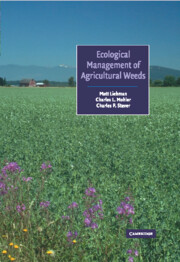Book contents
- Frontmatter
- Contents
- Preface
- 1 Weed management: a need for ecological approaches
- 2 Weed life history: identifying vulnerabilities
- 3 Knowledge, science, and practice in ecological weed management: farmer–extensionist–scientist interactions
- 4 Mechanical management of weeds
- 5 Weeds and the soil environment
- 6 Enhancing the competitive ability of crops
- 7 Crop diversification for weed management
- 8 Managing weeds with insects and pathogens
- 9 Livestock grazing for weed management
- 10 Weed evolution and community structure
- 11 Weed management: the broader context
- Taxonomic index
- Subject index
8 - Managing weeds with insects and pathogens
Published online by Cambridge University Press: 10 November 2009
- Frontmatter
- Contents
- Preface
- 1 Weed management: a need for ecological approaches
- 2 Weed life history: identifying vulnerabilities
- 3 Knowledge, science, and practice in ecological weed management: farmer–extensionist–scientist interactions
- 4 Mechanical management of weeds
- 5 Weeds and the soil environment
- 6 Enhancing the competitive ability of crops
- 7 Crop diversification for weed management
- 8 Managing weeds with insects and pathogens
- 9 Livestock grazing for weed management
- 10 Weed evolution and community structure
- 11 Weed management: the broader context
- Taxonomic index
- Subject index
Summary
Introduction
Weeds and other plant species are susceptible to attack by a diversity of invertebrate herbivores and pathogens. Virtually every plant organ provides a niche for some type of insect, mite, nematode, fungus, bacterium, or virus (Harper, 1977, p. 484). Protection of crop plants from these organisms is a major issue in crop production. Conversely, the promotion of herbivory and disease to suppress weed recruitment, growth, and reproduction is a major objective of biological control programs.
Biological control of weeds requires that sufficiently high densities of herbivores and pathogens are present when weeds are at susceptible developmental stages. For this to happen, herbivores and pathogens used as biological control agents must be well adapted to abiotic components of the environment, such as temperature and precipitation regimes (Crawley, 1986; Cullen, 1995). To control weeds effectively, they must also largely escape the effects of predation, parasitism, disease, competition, and chemical interference (Newman, Thompson & Richman, 1998).
Three approaches are used in efforts to regulate weed populations with herbivores and pathogens (Andow, Ragsdale & Nyvall, 1997). Conservation methods involve modifying the environment to retain or increase populations of resident control agents and intensify the damage they inflict on weeds. Inoculation methods involve introducing relatively small numbers of biological control agents that will suppress a target weed species as their populations establish, increase, and disperse.
- Type
- Chapter
- Information
- Ecological Management of Agricultural Weeds , pp. 375 - 408Publisher: Cambridge University PressPrint publication year: 2001
- 4
- Cited by



